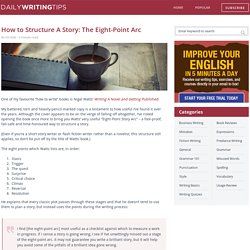

How to Structure A Story: The Eight-Point Arc. By Ali Hale - 3 minute read One of my favourite “how to write” books is Nigel Watts’ Writing A Novel and Getting Published.

My battered, torn and heavily-pencil-marked copy is a testament to how useful I’ve found it over the years. Although the cover appears to be on the verge of falling off altogether, I’ve risked opening the book once more to bring you Watts’ very useful “Eight-Point Story Arc” – a fool-proof, fail-safe and time-honoured way to structure a story. (Even if you’re a short story writer or flash fiction writer rather than a novelist, this structure still applies, so don’t be put off by the title of Watts’ book.) The eight points which Watts lists are, in order: StasisTriggerThe questSurpriseCritical choiceClimaxReversalResolution He explains that every classic plot passes through these stages and that he doesn’t tend to use them to plan a story, but instead uses the points during the writing process: So, what do the eight points mean? Stasis Trigger The quest Surprise Climax Reversal. 25 Ways To Fight Your Story's Mushy Middle. For me, the middle is the hardest part of writing.

It’s easy to get the stallions moving in the beginning — a stun gun up their asses gets them stampeding right quick. I don’t have much of a problem with endings, either; you get to a certain point and the horses are worked up into a mighty lather and run wildly and ineluctably toward the cliff’s edge. But the middle, man, the motherfucking middle. It’s like being lost in a fog, wandering the wasteland tracts. And I can’t be the only person with this problem: I’ve read far too many books that seem to lose all steam in the middle.
Seems like it’s time for another “list of 25″ to the rescue, then. Hiyaa! 1. Fuck the three-act structure right in its crusty corn-cave. 2. Hey, when you fake an orgasm, you gotta commit. 3. The shape of a story — especially the shape of a story’s middle — is a lot of soft rises and doughy plateaus and zoftig falls. 4. 5. 6. Sometimes, a story just needs blood. 7. 8. Find approximate middle of book. 9. 10. Well, At Least There Was Good Stuff to Read: The Books of the Decade. Anybody remember how anxious and thrilled we were in those last months of the 20th century?

When we weren't at war and we had a budget surplus and it looked like Al Gore would be president? The prospect of a 21st century filled with new technologies, new art and literature loomed large and bright. But now, as we look back at what was decidedly a shitty decade for an incredible variety of people in an equally incredible variety of ways (evictions/invasions/bombings/etc), it's surprisingly hard to be pessimistic about the books that assessed, satirized, dramatized and distracted us from the events of the past 10 years. Goethe said that the decline of a nation's literature is the precursor to that nation's fall, and with this look back at the books that defined the decade, we'd like to tell Goethe to suck it. Almost in spite of ourselves, we're still writing, translating, publishing and even occasionally buying good books in this country.